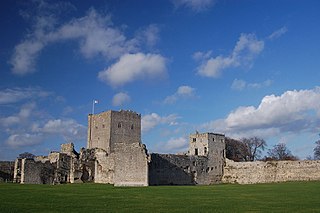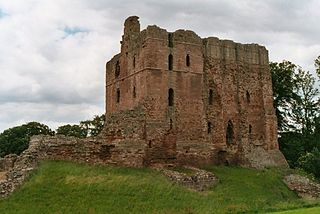Related Research Articles

Richard of Conisbrough, 3rd Earl of Cambridge was the second son of Edmund of Langley, 1st Duke of York, and Isabella of Castile, Duchess of York. He was beheaded for his part in the Southampton Plot, a conspiracy against King Henry V. He was the father of Richard Plantagenet, 3rd Duke of York, and the grandfather of King Edward IV and King Richard III.

Ralph Neville, 1st Earl of WestmorlandEarl Marshal, was an English nobleman of the House of Neville.
Margaret of Norfolk or Margaret of Brotherton, Duchess of Norfolk in her own right, was the daughter and eventual sole heir of Thomas of Brotherton, eldest son of King Edward I of England by his second marriage. In 1338, she succeeded to the earldom of Norfolk and the office of Earl Marshal. In 1397, she was created Duchess of Norfolk for life.

Henry Scrope, 3rd Baron Scrope of Masham KG, also known in older sources as Lord Scrope was a favourite of Henry V, who performed many diplomatic missions. He was beheaded for his involvement in the notional Southampton Plot to assassinate the king. Some historians believe that the charge was trumped-up to punish him for other acts of disloyalty, and that there may never have been such a plot.

Thomas West, 1st Baron West was an English nobleman and member of parliament.

The Southampton Plot was a conspiracy to depose King Henry V of England, revealed in 1415 just as the king was about to sail on campaign to France as part of the Hundred Years' War. The plan was to replace him with Edmund Mortimer, 5th Earl of March.

Sir Thomas Grey, of Heaton Castle in the parish of Norham, Northumberland, was one of the three conspirators in the failed Southampton Plot against King Henry V in 1415, for which he was executed.
Isabel of Cambridge, Countess of Essex was the only daughter of Richard, 3rd Earl of Cambridge, and Anne de Mortimer. She was the sister of Richard Plantagenet, 3rd Duke of York, and like him a great-grandchild of Edward III of England.
John (II) de Mowbray, 3rd Baron Mowbray was the only son of John de Mowbray, 2nd Baron Mowbray, by his first wife, Aline de Brewes, daughter of William de Braose, 2nd Baron Braose. He was born in Hovingham, Yorkshire.

John (III) de Mowbray, 4th Baron Mowbray was an English peer. He was slain near Constantinople while en route to the Holy Land.

John (IV) de Mowbray, 1st Earl of Nottingham, 5th Baron Mowbray, 6th Baron Segrave, was an English peer.
William Grey was a medieval English churchman, academic, and Lord High Treasurer. He served as Chancellor of Oxford University and as Bishop of Ely.

Richard de Vere, 11th Earl of OxfordKG was the son and heir of Aubrey de Vere, 10th Earl of Oxford. He took part in the trial of Richard, Earl of Cambridge, and Lord Scrope for their part in the Southampton Plot, and was one of the commanders at Agincourt in 1415.

Sir Thomas Grey or Gray of Heaton Castle in the parish of Cornhill-on-Tweed, Northumberland, was the son of Sir Thomas Grey, an eminent soldier in the Anglo-Scottish wars in the reigns of Edward I and Edward II, and his wife, Agnes de Bayles. He was the author of the English chronicle, the Scalacronica.
Eleanor de Mowbray was the daughter of John de Mowbray, 4th Baron Mowbray, and Elizabeth de Segrave, 5th Baroness Segrave, daughter and heiress of John de Segrave, 4th Baron Segrave. She had two brothers and two sisters:
Alianore Holland, Countess of March was the eldest daughter of Thomas Holland, 2nd Earl of Kent, and the wife of Roger Mortimer, 4th Earl of March, heir presumptive to her uncle, King Richard II. Through her daughter, Anne Mortimer, she was the great-grandmother of the Yorkist kings Edward IV and Richard III. She was governess to Richard II's wife, Isabella of Valois.
Richard le Scrope was an English cleric who served as Bishop of Coventry and Lichfield and Archbishop of York and was executed in 1405 for his participation in the Northern Rising against King Henry IV.

John Grey, 1st Earl of Tankervillejure uxoris6th Lord of Powys, KG, was an English peer who served with distinction in the Hundred Years' War between England and France under King Henry V.

John Segrave, 4th Baron Segrave was an English peer and landowner in Leicestershire and Yorkshire. His family title of Baron Segrave is drawn from a village now spelled Seagrave, which uses a coat of arms imitated from that of the family.
Heaton Castle in the parish of Cornhill-on-Tweed, Northumberland, England, is a ruined historic castle near the Scottish border.
References
- Fryde, E. B.; Greenway, D. E.; Porter, S.; Roy, I. (1996). Handbook of British Chronology (Third revised ed.). Cambridge: Cambridge University Press. ISBN 0-521-56350-X.
- Haines, Roy Martin (2009). Gray, William (c.1388–1436). Dictionary of National Biography . Retrieved 14 October 2012.
- Charles Mosley, editor, Burke's Peerage, Baronetage & Knightage, 107th edition, 3 volumes (Wilmington, Delaware, U.S.A.: Burke's Peerage (Genealogical Books) Ltd, 2003), volume 2, p. 1661.
- Pugh, T.B. (1988). Henry V and the Southampton Plot of 1415. Alan Sutton. ISBN 0-86299-541-8.
- Richardson, Douglas (2011). Magna Carta Ancestry: A Study in Colonial and Medieval Families, ed. Kimball G. Everingham. Vol. II (2nd ed.). Salt Lake City. ISBN 978-1449966386.
{{cite book}}: CS1 maint: location missing publisher (link) - Richardson, Douglas (2011). Magna Carta Ancestry: A Study in Colonial and Medieval Families, ed. Kimball G. Everingham. Vol. III (2nd ed.). Salt Lake City. ISBN 978-1449966393.
{{cite book}}: CS1 maint: location missing publisher (link)